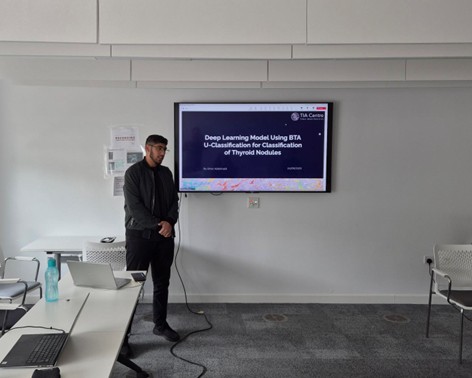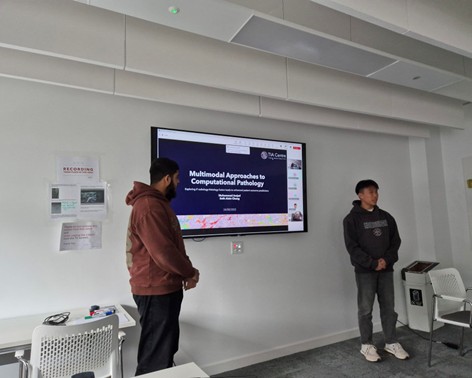TIA Centre: News
To see our previous half-yearly newsletters click here.
TIA Summer Research Internships 2025
This summer, the TIA Centre at the University of Warwick welcomed three exceptional undergraduate students for an eight-week research internship, co-funded by the Warwick Undergraduate Research Support Scheme (URSS) and the Applied Computing research theme.
Working under the supervision of Dr Adam Shephard and Professor Nasir Rajpoot, the interns explored advanced applications of artificial intelligence (AI) in medical imaging and computational pathology. Their projects tackled real-world healthcare challenges, combining technical innovation with clinical relevance.
Research Projects
- Muhammad Amjad (4th year Mathematics) and Seth Chang (3rd year Computer Science)
Project: AI Methods for Integrating Histology and Radiology for Prognostication
This joint project investigated how transformer-based models and multimodal fusion techniques can be used to improve prognostic predictions in cancer diagnostics. The students trained deep learning models on histology and radiology data, explored fusion architectures, and evaluated performance using the TIA Centre’s high-performance computing infrastructure. - Omar Abdelrazik (2nd year Computer Science)
Project: Deep Learning Model Using U-Classification for Diagnosis of Thyroid Nodules
Omar led a project focused on thyroid ultrasound classification, collaborating with a neuroradiologist from University Hospital of North Midlands (UNHM). He developed segmentation models to isolate thyroid nodules and designed pipelines to map extracted features to the British Thyroid Association’s U-class system, demonstrating how AI can support clinical decision-making in endocrine imaging.
All three interns are currently preparing their work for submission to the IEEE International Symposium on Biomedical Imaging (ISBI) 2026, to be held in London.
Reflections from the Interns
Seth said:
“It was a really fulfilling few weeks at the TIA Centre doing research in a field that could potentially enrich lives all over the world. I learned a lot about computational pathology and research methodologies, and realised that even when experiments don’t go as planned, there’s always something valuable to take away. I am glad to have had this opportunity, and am extremely grateful to Adam and Nasir for their guidance!”
Muhammad shared:
“I was drawn to the TIA Centre to see how machine learning could be applied to real-world healthcare problems. During the internship, I worked on computational pathology research, exploring how technologies like transformers and multimodal fusion are shaping the field. I developed a much deeper understanding of computer vision and different ML architectures, and learned how tools such as CNNs and transformer based foundational models can be used to extract meaningful information from medical images. I particularly enjoyed the process of discovery and experimentation throughout the project. The research-focused environment offered a lot of freedom to explore different approaches, while still providing support and guidance from leading researchers. What stood out to me most was the impact research in this field could have and how our work could one day contribute to improving diagnostic tools in healthcare. It was motivating to contribute, even in a small way, to a field which has the potential to make such real-world change.”
Omar reflected:
“My internship gave me the opportunity to explore how deep learning can be used to address real challenges in medical imaging. I gained a much deeper understanding of convolutional and transformer-based architectures, medical image analysis, and the challenges of working with complex, multimodal data. I’m especially grateful for the incredible support and guidance I received throughout the project — particularly from Dr Adam Shephard, who continuously provided feedback and direction, and from Prof Nasir Rajpoot, Dr Noorul Wahab, and other members of the TIA Centre who offered valuable insights and suggestions during discussions and presentations. What I enjoyed most was the balance between research freedom and guidance — being able to experiment with model design while learning from experienced researchers and clinicians. The internship not only strengthened my technical skills in machine learning and image processing but also gave me valuable insight into how AI can support clinical decision-making and contribute to improving diagnostic accuracy in healthcare.”
Final Presentation and Next Steps
At the end of their internship, the students presented their work to the wider TIA Centre community. Their presentations showcased not only technical depth but also the enthusiasm and curiosity that defined their time at the Centre. A recording of the presentations will be available soon on the TIA Centre YouTube channel.
We are incredibly proud of their achievements and look forward to seeing their continued contributions to the field of AI in healthcare.
By Adam Shephard

Omar presenting his work to the TIA Centre.

Muhammad and Seth presenting their project to the TIA Centre.
Newsletters
Newsletters from 2024/25:
